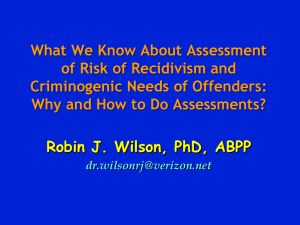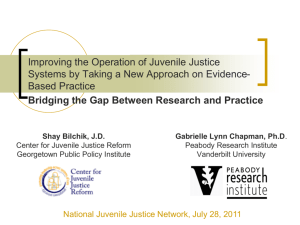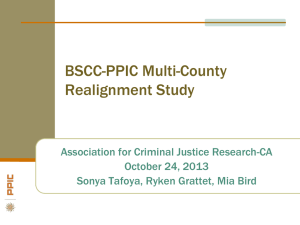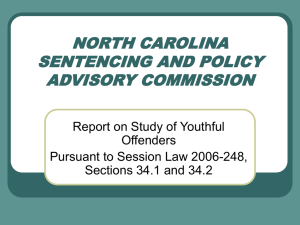Evidence - Based Interventions: Musings on Evidence, Meta
advertisement
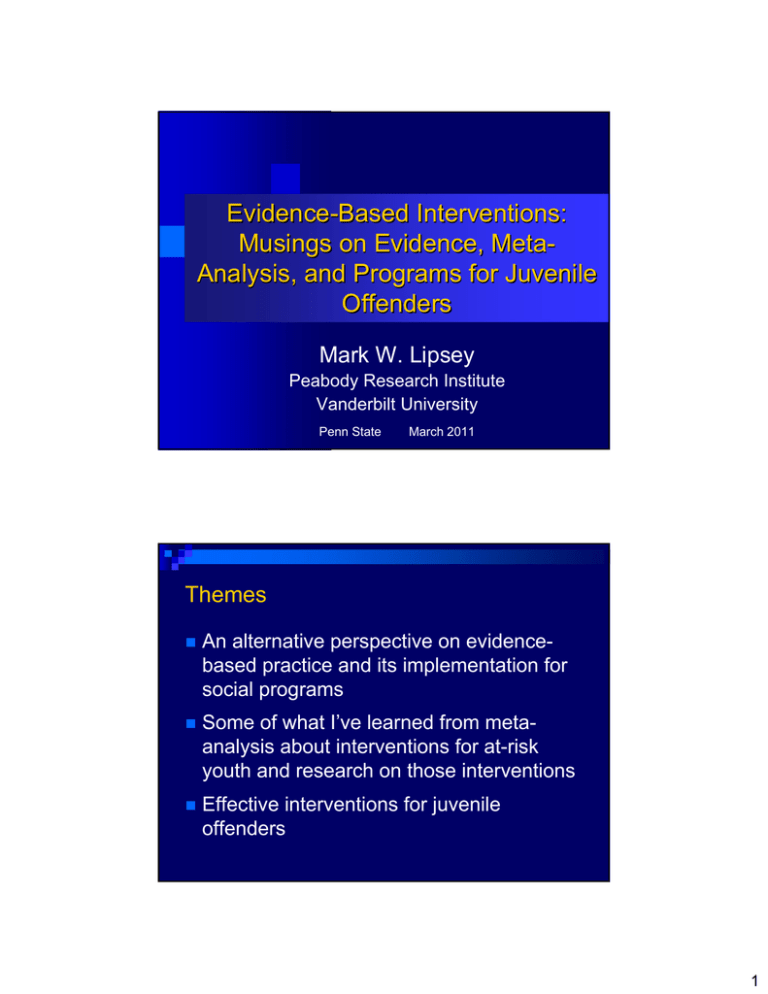
Evidence-Based Interventions: Musings on Evidence, MetaAnalysis, and Programs for Juvenile Offenders Mark W. Lipsey Peabody Research Institute Vanderbilt University Penn State March 2011 Themes An alternative perspective on evidencebased practice and its implementation for social programs Some of what I’ve learned from metaanalysis about interventions for at-risk youth and research on those interventions Effective interventions for juvenile offenders 1 Conventional definition of evidencebased practice: ‘Brand name’ protocol programs Examples for juvenile offenders: Functional Family Therapy (FFT) Multisystemic Therapy (MST) Multidimensional Treatment Foster Care Aggression Replacement Training (ART) Lists of “model” programs certified by some group as supported by credible research Blueprints for Violence Prevention National Registry of Evidence-based Programs and Practices (NREPP) Helping America’s Youth (HAYS) community guide OJJDP Model Programs Guide 2 Protocol programs as evidence-based practice Evidence base: Evaluation studies of implementations of that protocol in different places (usually only a few studies) Assumptions: Implemented with fidelity Generalizable beyond the original studies Specificity assumption for protocol programs Program A works Similar Program B doesn’t work The difference is because Program A has effective ‘active ingredients’ Program B may be similar in other ways but lacks those effective ingredients 3 Alternate perspective on what constitutes a social program: Generic intervention types Examples for juvenile offenders: Interpersonal skills training Family therapy Group counseling Cognitive behavioral therapy Within a type, similar activities and interactions between providers and juveniles Allows broader consideration of what differentiates similar effective and ineffective programs Evidence base: Evaluation studies of different programs of that type in different places (often many studies). Allows examination of the specificity assumption and exploration of other program characteristics that may be associated with effectiveness 4 Case example: Programs for juvenile offenders Outcome of primary interest: reoffense rates * Interventions that reduce reoffense rates also have positive effects on: Mental health indicators and interpersonal adjustment School participation and performance Vocational accomplishments Meta-analysis of existing studies of interventions for juvenile offenders 548 independent study samples Juveniles aged 12-21 Intervention intended to have positive effects on subsequent delinquency At least one delinquency outcome Random assignment or, if not, pretreatment differences reported or matched 5 Examples of information coded into the meta-analysis database Distribution of effect sizes for cognitive behavioral programs Average recidivism reduction of 25% 6 Mix of brand name & ‘home grown’ programs R&R MRT ART Distribution of effect sizes for family therapy interventions Family Interventions Covariate-Adjusted Recidivism Effect Sizes (N=29) >.00 Average recidivism reduction of 13% -.40 -.30 -.20 -.10 .00 .10 .20 .30 .40 .50 .60 Median Effect Size (zPhi coefficient) 7 Brand name model programs in this distribution Family Interventions Covariate-Adjusted Recidivism Effect Sizes (N=29) >.00 FFT MST -.40 -.30 -.20 -.10 .00 .10 .20 .30 .40 .50 .60 Median Effect Size (zPhi coefficient) Effect sizes analyzed as a function of study and program characteristics 8 Method matters (a lot) Effect size differences associated with: Outcome measurement (type of recidivism, timing) Design (initial equivalence; design type) Sample size Publication source Used as statistical control variables Some characteristics of the juveniles matter Effect size differences associated with: Delinquency risk (strong positive) Aggressive history (moderate negative) Effect size differences not associated with: Mean age Gender mix Ethnicity 9 JJ supervision level doesn’t matter much (with risk, etc. controlled) Effect size differences not associated with: No JJ supervision (prevention programs) Diversion Probation/parole Incarceration Type of program matters Programs are identified first according to their broad approach or “philosophy:” Control philosophies Therapeutic philosophies And, second, by their generic type, e.g., group counseling, interpersonal skills, cognitive behavioral therapy 10 Treatment “philosophy” matters Therapeutic interventions Discipline Deterrence Surveillance Restorative Skill building Counseling Multiple services -10 -5 0 5 10 15 % Recidivism Reduction from .50 Baseline Type of intervention: Skill-building Behavioral Cognitive-behavioral Social skills Challenge Academic Job related 0 5 10 15 20 25 30 % Recidivism Reduction from .50 Baseline 11 Type of intervention: Counseling Individual Mentoring Family Family crisis Group Peer Mixed Mixed w/referrals 0 5 10 15 20 25 % Recidivism Reduction from .50 Baseline How well the program is implemented matters: Service amount and quality Effect size differences associated with: Duration of service Total hours of service Quality of implementation Along with intervention type, the strongest predictors of effects 12 These findings suggest simple ‘best practice’ guidelines Program type: Therapeutic approach and one of the more effective intervention types For a given intervention type: Risk: Larger effects with high risk juveniles Dose: Amount of service that at least matches the average in the supporting research High quality implementation: Treatment protocol and monitoring for adherence Operationalizing these practice guidelines at scale: The Standardized Program Evaluation Protocol (SPEP) A rating system for each program type within the therapeutic philosophies Applied to individual programs based on data about the services actually provided Pilot projects with the juvenile justice systems of Arizona, North Carolina, & Tennessee 13 Standardized Program Evaluation Protocol (SPEP) for Services to Probation Youth Points assigned proportionate to the contribution of each factor to recidivism reduction Target values from the metaanalysis (generic) OR program manual (manualized) Possible Points Received Points Primary Service: High average effect service (35 points) Moderate average effect service (25 points) Low average effect service (15 points) Supplemental Service: Qualifying supplemental service used (5 points) 35 5 Treatment Amount: Duration: % of youth that received target number of weeks of service or more: 0% (0 points) 60% (6 points) 20% (2 points) 80% (8 points) 40% (4 points) 100% (10 points) Contact Hours: % of youth that received target hours of service or more: 0% (0 points) 60% (9 points) 20% (3 points) 80% (12 points) 40% (6 points) 100% (15 points) Treatment Quality: Rated quality of services delivered: Low (5 points) Medium (10 points) 10 15 15 High (15 points) Youth Risk Level: % of youth with the target risk score or higher: 25% (5 points) 75% (15 points) 50% (10 points) 99% (20 points) Provider’s Total SPEP Score: 20 100 [INSERT SCORE] Validity study: Does it work? Arizona Juvenile Justice Services Division Programs provided during 2005-06 to juvenile probationers in five pilot counties 1490 juveniles who received services from 66 SPEP rated programs 6-month recidivism data on all; 12-month recidivism for most 14 Distribution of SPEP scores across programs 30 25 73% have scores < 50 34.8% Number of Programs 31.8% 20 15 16.7% 10 5 6.1% 4.5% 4.5% 60-69 70-79 1.5% 0 20-29 30-39 40-49 50-59 80-85 Total SPEP Score Actual vs. predicted recidivism for 6-mo providers with scores ≥ 50 and < 50 recidivism 6-mo recidivism difference: Low score difference: High score 6-Month Recidivism Difference -0.12 -0.01 SPEP ≥ 50 SPEP < 50 12-Month Recidivism Difference 12-mo recidivism difference: Low score -0.13 -0.01 12-mo recidivism difference: High score -0.14 -0.12 -0.1 -0.08 -0.06 -0.04 -0.02 0 0.02 Actual Minus Predicted Recidivism Difference 15 Final musings The name brand “model” program is not the only approach to effective evidencebased practice Meta-analysis is important for investigating the factors associated with effectiveness Key factors: Intervention type and quality of implementation Challenge of scaling up effective intervention approaches Thanks! Questions? Comments? 16
